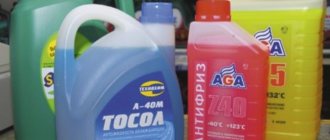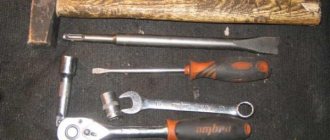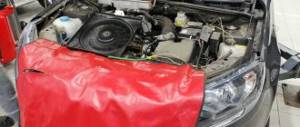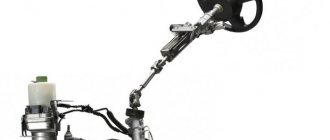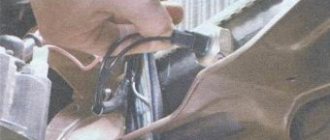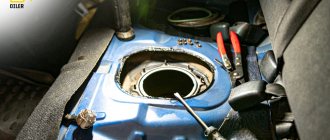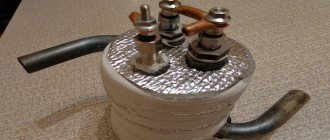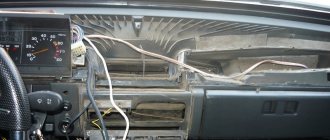Owners of a UAZ Patriot SUV are not afraid of off-road travel, mud and ponds. Driving a car weighing approximately two tons is very problematic. But to make movement comfortable and convenient, to improve steering rotation, a power steering system has been created - power steering.
The purpose of the power steering is to ease the rotational forces of the car's wheels. With the creation of power steering, you can turn the steering wheel and wheels without much effort - almost with one finger. The hydraulic booster is equipped with a pump that starts working when the vehicle's power unit is turned on. Rotation occurs due to a belt drive. At this moment, oil begins to flow into the power steering system.
The fluid is the substance that facilitates the operation of the steering wheel. Through a special hose, oil flows from the pump to the power steering control system. As the machine operates, the oil creates pressure, thereby improving the rotation of the steering wheel.
Like any fluid, the oil in the power steering must be replaced periodically. The UAZ Patriot maintenance instructions say that the UAZ Patriot power steering fluid is replaced every 100 thousand km of the SUV.
Signs of the need to replace power steering fluid on a UAZ Patriot
The power steering is an integral part of the UAZ Patriot vehicle. The safety and comfort of driving a vehicle depends on its operation. And for the high-quality and uninterrupted operation of the power steering, the presence of fluid in the power steering system is of particular importance.
It is necessary to change the oil not only taking into account the mileage traveled, but also if a number of additional reasons arise.
An unplanned replacement of power steering fluid in a UAZ Patriot is necessary for the following reasons:
- The steering wheel is difficult to turn;
- Extraneous noise when the power steering and pump are operating. Often the pump in the system is the weak element;
- Steering problems;
- Oil leak from the power steering system.
If you encounter one of the problems listed above, you should perform maintenance on the SUV, namely, replacing the working fluid in the power steering system.
The operation of the hydraulic power steering of the UAZ Patriot can be disrupted by wear of the power steering hose, clogging of the cleaning filter, or breakdown of the hydraulic system pump. You can correct breakdowns and improve the operation of the power steering by replacing the worn element with a new one.
Selecting steering fluid
The oil in the hydraulic power steering is the main element for the safe and comfortable movement of an SUV. The operating instructions indicate that the power steering fluid in the UAZ Patriot is changed once every two years or after the vehicle has reached the required mileage. Changing the oil depends on the driving style and intensity of use of the SUV.
You can fill your car with automatic transmission oil. All power steering fluids can be divided according to criteria such as color, type and composition. The recommended power steering oil is Mobil ATF 220, 2 liters.
Based on their composition, power steering oils are divided into mineral, semi-synthetic and synthetic. You cannot mix synthetic and mineral-based fluids with each other, since the types of additives in them are different.
To choose the right fluid for the power steering system, you should familiarize yourself with the manufacturer's recommendations. Often information about gur oil is indicated on the expansion tank or cap. That is why, replacing the power steering fluid on a UAZ Patriot is carried out in accordance with the instructions and recommendations of the automaker.
Purpose
The main purpose of the power steering is to facilitate the rotation of the wheels through a hydraulic device. What does this mean? This means that turning the wheels on a UAZ Patriot SUV when its engine is not running is quite difficult, and if there were no power steering, maneuvers on the roads, and even more so off-road, would simply be impossible. Thanks to the power steering, it is possible to rotate the steering wheel and wheels, respectively, using one finger of either hand, which simplifies driving and maneuvering on the road.
Step-by-step instructions for changing power steering fluid
If basic safety rules are observed and the necessary tools are available, the owner of a UAZ Patriot can begin the main work.
To change the fluid in the power steering, you must have the following tools:
- Large syringe with a tube;
- Container for draining old oil;
- New fluid;
- Rubber or regular gloves;
- Clean rag.
Work on changing the lubricant must be carried out with a lift. If it is missing, you can install the car on an inspection hole or lift it with two jacks. Use a jack to lift the front wheels of the car.
The process of draining waste fluid:
- Place the car on a lift or jack up the front;
- If there is a front mudguard, it must be removed;
- Open the cap of the power steering expansion tank;
- Loosen the clamp that secures the expansion tank;
- Prepare a container for used oil;
- Use a syringe with a tube to pump out the lubricant or, tilt the tank, drain the liquid into a container;
- Disconnect the return hose from the tank and lower it into the prepared container;
- Turn the steering wheel in different directions until it stops 2 - 3 times;
- There is no need to start the power unit at this stage;
- Remove the empty tank and rinse thoroughly;
The expansion tank contains a filter for cleaning the liquid. It should be removed and replaced with a new filter. At this stage, draining the power steering fluid from the UAZ Patriot has been successfully completed.
The replacement of fluid in the power steering of the UAZ Patriot is completed by filling in new oil:
- Having installed the expansion tank in place, fill in new oil with a syringe;
- Turn the steering wheel right and left all the way with the engine not running, constantly adding oil to the tank;
- When the steering wheel is rotated, old grease flows out of the drain hose; it is dark in color. If light oil appears when draining, stop pumping;
- Reassemble the power steering system;
- Start the engine by turning the steering wheel from lock to lock;
- Add fluid to the level indicated on the reservoir.
This completes the replacement of fluid in the power steering of the UAZ Patriot.
When performing work, the driver must take into account the following recommendations:
- To eliminate the load on the steering system, the car should be suspended during bleeding;
- The average oil change volume is 1.2 liters;
- After replacing the fluid, lower the car and start the power unit. The engine should idle for approximately 10 - 15 minutes.
When draining the power steering oil of a UAZ Hunter, it is necessary to replace the filter of the hydraulic system pump. The filter is removed from the expansion tank by pulling out the cotter pin from the axis, removing the washer, pressure spring and sealing sleeve (rubber). Before installing a new cleaning element, wipe the inside of the expansion tank from dirt. After cleaning the tank, you can install a new filter in the reverse order as it was removed.
Changing the power steering fluid in a UAZ Hunter is not much different in its process from changing the oil in a UAZ Patriot. The UAZ Hunter uses Dexron II or Dexron III transmission oil as a fill fluid. They can be mixed. The volume of the Hunter power steering fluid filled is 1.1 liters.
At the final stage of engine operation, you should carefully check the connection points of the hoses to the elements of the power steering system for fluid loss. If a leak is detected, it should be repaired immediately.
It is worth clarifying that when changing the brand of the substance, the power steering system must be flushed with the oil that is poured into it. Only timely maintenance such as replacing fluid in the power steering and preventive repairs will ensure uninterrupted operation of the entire hydraulic power steering system.
Fluids used in power steering can be divided according to several criteria:
- Color;
- Compound;
- Variety.
Mechanism design
Power steering is a device directly involved in driving a car and designed to improve the comfort of steering wheel rotation.
In addition to the hydraulic booster, there are also:
- Pneumatic.
- Electrically.
- Mechanical.
Power steering UAZ 31512
All of them are designed to simplify the driver’s control process, but they work differently and can have different effects on the car as a whole. So, the pneumatic amplifier is based on the principle of air pressure. This option is the most structurally complex and unreliable, which is why it is rarely installed anywhere. In its system, it has a cylinder into which air is pumped, a compressor that pumps this same air and creates pressure and a mass of tubes and a hose through which the air moves into the mechanism. The slightest malfunction in the operation of even one element, and the entire system collapses. Those who, on duty, drove KRAZ vehicles that were produced back in Soviet times know firsthand that this amplifier practically never works and you have to turn the steering wheel of the truck with all your muscle strength.
Our UAZ 31512 is equipped with power steering - this is the simplest and most reliable option that can be offered. All its components, including the reinforcement mechanism, rack, pump for creating pressure, etc., fit in one place and are not dispersed throughout the car.
Only the expansion tank is located separately to make it easier for the driver to change the fluid in the entire system. Power steering works in principle the same way hydraulic brakes work, with the only difference being that there is always a booster pump that creates fluid pressure on the rack, which helps turn the steering wheel in the right direction.
Color classification
It is wrong to be guided only by color gradation when choosing oil, although this practice is widespread among car owners. It is also often indicated what color liquids can be mixed and which ones should not be mixed.
Mixing is contraindicated with liquids based on composition and not color, and since now both mineral water and synthetics can be presented in any color, you should treat this information very carefully.
Red ATF gear oil is usually synthetic, the Dexron brand from General Motors is considered the standard, but there are products from other manufacturers, such as Revenol, Motul, Shell, Zic, etc.
Yellow oil, produced by the Daimler concern and under its license, is used in Mercedes-Benz hydraulic boosters. It can be synthetic and mineral.
Green oil. For the most part, multifunctional and universal liquids can be either synthetic or mineral in composition. They are used in power steering, suspension and other systems that operate on liquids. It cannot be mixed with other colors, except in cases where the manufacturer declares full compatibility, for example Comma PSF MVCHF is compatible with some types of Dexron.
Liquid composition
Based on the composition of the power steering fluid, it can be divided into mineral, semi-synthetic and synthetic. The chemical composition determines the basic set of oil functions:
- Viscosity characteristics;
- Lubricating properties;
- Protection of parts from corrosion;
- Prevents foaming;
- Temperature and hydraulic properties.
Synthetics and mineral water cannot be mixed with each other, since the types of additives in them have fundamental differences.
Synthetics
These are high-tech liquids, in the production of which the most modern developments and additives are used. Oil fractions for synthetics are purified by hydrocracking. Polyesters, polyhydric alcohols and sets of additives give them outstanding characteristics: a wide range of operating temperatures, stable oil film, long service life.
The main reason why synthetic-based hydraulic fluid cannot be poured into power steering intended for mineral ones is its aggressive effect on rubber products, of which there are many in the hydraulic booster. Where synthetics are used, the rubber has a completely different composition and is made on a silicone basis.
Semi-synthetics
A mixture of synthetic and mineral oils, due to which the latter receive significant improvements in performance: reduced foaming, fluidity, heat dissipation.
Semi-synthetic fluids include such well-known fluids as: Zic ATF Dex 3, Comma PSF MVCHF, Motul Dexron III and others.
Mineralka
Mineral-based oils contain petroleum fractions (85-98%), the rest are additives that improve the performance of the hydraulic fluid.
They are used in hydraulic boosters containing seals and parts based on ordinary rubber, since the mineral component is neutral and is not harmful to rubber products, unlike synthetics.
Mineral power steering fluids are the most inexpensive, but they also have a short service life. Mobil ATF 320 Premium is considered a good mineral oil; Dexron oils up to and including the IID marking were also mineral.
Different types of oils
Dexron
- a separate class of ATF fluids from General Motors, produced since 1968. Dexron is a trademark, produced both by GM itself and by other companies under license.
ATF
(Automatic Transmission Fluid) - oils for automatic transmissions, often used by Japanese automakers and in power steering.
P.S.F.
(Power Steering Fluid) - literally translated as power steering fluid.
Multi HF
– special, universal power steering fluids that have approvals from most automobile manufacturers. For example, CHF liquid, produced by the German company Pentosin, has received approvals from BMW, Ford, Chrysler, GM, Porsche, Saab and Volvo, Dodge, Chrysler.
Disassembling the power steering pump
And so, first of all, we remove the pump, you need to drain all the liquid from it (I think everyone can figure out how to remove it and drain the liquid), and on the back cover of the power steering you need to unscrew the four bolts with a 14mm head.
Read more: Chain pr 25 4 6000 sizes
After that, we begin to carefully remove the cover, try not to damage the gasket (this gasket has an internal rubber seal), in the power steering housing we leave the outer part of the “working ellipse cylinder” (hereinafter simply the cylinder). There is no need to be scared when the cover comes away from the body, it may seem that it is coming away due to the action of the spring, when reassembling it will seem to you that it does not fit into place, just continue to carefully and alternately tighten the bolts diagonally, then everything will fall into place .
Is it possible to fill the power steering with engine oil?
Motor - definitely not, transmission - with reservations. Next we will look in detail why.
To understand whether other oils, such as motor or transmission oils, can be poured into the power steering, you need to know what functions it performs.
The power steering fluid must cope with the following tasks:
- Lubrication of all power steering components;
- Protection against corrosion and wear of parts;
- Pressure transfer;
- Prevents foaming;
- System cooling.
The above characteristics are achieved by adding various additives, the presence and combination of which gives power steering oil the necessary qualities.
As you understand, the tasks of motor oil are somewhat different, so it is highly not recommended to pour it into the power steering.
Regarding transmission oil, everything is not so clear; the Japanese often use the same ATF fluid for automatic transmission and power steering. Europeans insist on using special PSF (Power Steering Fluid) oils.
What kind of fluid to pour into the power steering
Based on this, the answer to the question “what kind of oil to pour into the power steering” is obvious - recommended by the manufacturer of your car. Often information is indicated on the expansion tank or cap. If there is no technical documentation, call an authorized center and ask.
In any case, experiments with steering are unacceptable. Not only your safety, but also that of those around you depends on the health of your power steering.
| car model | Recommended liquid |
| Audi 80, 100 (audi 80, 100) | VAG G 004 000 M2 |
| Audi A6 C5 (audi a6 c5) | Mannol 004000, Pentosin CHF 11S |
| Audi a4 (audi a4) | VAG G 004 000M2 |
| Audi a6 c6 (audi a6 c6) | VAG G 004 000M2 |
| BMW e34 (BMW e34) | CHF 11.S |
| BMW E39 (BMW E39) | ATF Dextron 3 |
| BMW E46 (BMW E46) | Dexron III, Mobil 320, LIQUI MOLY ATF 110 |
| BMW E60 (BMW E60) | Pentosin chf 11s |
| BMW x5 e53 (BMW x5 e53) | ATF BMW 81 22 9 400 272, Castrol Dex III, Pentosin CHF 11S |
| VAZ 2110 | |
| VAZ 2112 | Pentosin Hydraulic Fluid (CHF,11S-tl, VW52137) |
| Volvo s40 (volvo s40) | Volvo 30741424 |
| Volvo xc90 (volvo xc90) | VOLVO 30741424 |
| Gas (Valdai, Sobol, 31105, 3110, 66) | |
| Gazelle business | Mobil ATF 320, Castrol-3, Liqui moly ATF, DEXTRON III, CASTROL Transmax Dex III Multivehicle, ZIC ATF III, ZIC dexron 3 ATF, ELF matic 3 |
| Gazelle next | Shell Spirax S4 ATF HDX, Dexron III |
| Geely MK | |
| Geely Emgrand | ATF DEXRON III, Shell Spirax S4 ATF X, Shell Spirax S4 ATF HDX |
| Dodge Stratus | ATF+4, Mitsubishi DiaQueen PSF, Mobil ATF 320 |
| Daewoo Gentra | Dexron-IID |
| Daewoo matiz | Dexron II, Dexron III |
| Daewoo Nexia | Dexron II, Dexron III, Top Tec ATF 1200 |
| Zaz chance | LiquiMoly Top Tec ATF 1100, ATF Dexron III |
| Zil 130 | T22, T30, Dexron II |
| Zyl bull | AU (MG-22A), Dexron III |
| Kamaz 4308 | TU 38.1011282-89, Dexron III, Dexron II, GIPOL-RS |
| Kia Carens | Hyundai Ultra PSF-3 |
| Kia rio 3 (Kia rio 3) | PSF-3, PSF-4 |
| Kia Sorento | Hyundai Ultra PSF-III, PSF-4 |
| Kia Spectra | Hyundai Ultra PSF-III, PSF-4 |
| Kia Sportage | Hyundai Ultra PSF-III, PSF-4 |
| Kia Cerato | Hyundai Ultra PSF-III, PSF-4 |
| Chrysler PT Cruiser | Mopar ATF 4+ (5013457AA) |
| Chrysler Sebring | Mopar ATF+4 |
| Lada Largus | Mobil ATF 52475 |
| Lada Priora | Pentosin Hydraulik Fluid CHF 11S-TL VW52137, Mannol CHF |
| Land Rover Freelander 2 | LR003401 pas fluid |
| Lifan smiley (lifan smily) | Dexron III |
| Lifan solano | Dexron II, Dexron III |
| Lifan X60 (lifan x60) | Dexron III |
| Maz | BRAND R (Oil MG-22-V) |
| Mazda 3 | Mazda M-3 ATF, Dexron III |
| Mazda 6 (mazda 6 GG) | Mazda ATF MV, Dexron III |
| Mazda cx7 (Mazda cx7) | Motul Dexron III, Mobil ATF320, Idemitsu PSF |
| Man 9 (Man) | MAN 339Z1 |
| Mercedes w124 (mercedes w124) | Dexron III, Febi 08972 |
| Mercedes w164 (mercedes w164) | A000 989 88 03 |
| Mercedes w210 (mercedes w210) | A0009898803, Febi 08972, Fuchs Titan PSF |
| Mercedes w211 (mercedes w211) | A001 989 24 03 |
| Mercedes Actros | Pentosin CHF 11S |
| Mercedes atego (mercedes atego) | Dexron III, Top Tec ATF 1100, MV 236.3 |
| Mercedes ML (mercedes ml) | A00098988031, Dexron IID, MB 236.3, Motul Multi ATF |
| Mercedes sprinter | Dexron III |
| Mitsubishi Outlander | Dia Queen PSF, Mobil ATF 320 |
| Mitsubishi Galant | Mitsubishi Dia Queen PSF, Mobil ATF 320, Motul DEXRON III |
| Mitsubishi Lancer 9, 10 (Mitsubishi Lancer) | Dia Queen PSF, Mobil ATF 320, Dexron III |
| Mitsubishi Montero Sport | Dexron III |
| Mitsubishi Pajero | Dia Queen PSF, Mobil ATF 320 |
| Mitsubishi Pajero 4 | Dia Queen PSF, Mobil ATF 320 |
| Mitsubishi Pajero Sport | Dia Queen PSF, Mobil ATF 320 |
| Mtz 82 | in summer M10G2, M10V2, in winter M8G2, M8V2 |
| Nissan Avenir | Dexron II, Dexron III, Dex III, Castrol Transmax Dex III Multivehicle |
| Nissan ad | NISSAN KE909-99931 "PSF |
| Nissan Almera | Dexron III |
| Nissan Murano | KE909-99931 PSF |
| Nissan Primera | ATF320 Dextron III |
| Nissan Teana J31 (Nissan Teana J31) | Nissan PSF KLF50-00001, Dexron III, Dexron VI |
| Nissan Cefiro | Dexron II, Dexron III |
| Nissan Pathfinder | KE909-99931 PSF |
| Opel Antara | GM Dexron VI |
| Opel Astra H (opel astra H) EGR | OPEL PSF 19 40 715, SWAG 99906161, FEBI-06161 |
| Opel Astra J | Dexron VI, General Motors 93165414 |
| Opel Vectra A | Dexron VI |
| Opel Vectra B | GM 1940771, Dexron II, Dexron III |
| Opel Mokka | ATF DEXRON VI" Opel 19 40 184 |
| Peugeot 206 | Total Fluide AT42, Total Fluide LDS |
| Peugeot 306 | Total Fluide DA, Total Fluide LDS |
| Peugeot 307 | Total Fluid DA |
| Peugeot 308 | Total Fluid DA |
| Peugeot 406 | Total Fluide AT42, GM DEXRON-III |
| Peugeot 408 | Total FLUIDE AT42, PENTOSIN CHF11S, Total FLUIDE DA |
| Peugeot partner | Total Fluide AT42, Total Fluide DA |
| Ravon Gentra | Dexron 2D |
| Renault duster | ELF ELFMATIC G3, ELF RENAULTMATIC D3, Mobil ATF 32 |
| Renault Laguna | ELF RENAULT MATIC D2, Mobil ATF 220, Total FLUIDE DA |
| Renault Logan | Elf Renaultmatic D3, Elf Matic G3 |
| Renault Sandero | ELF RENAULTMATIC D3 |
| Renault simbol | ELF RENAULT MATIC D2 |
| Citroen Berlingo | TOTAL FLUIDE ATX, TOTAL FLUIDE LDS |
| Citroen C4 (Citroen C4) | Total Fluide DA, TOTAL FLUIDE LDS, Total Fluide AT42 |
| Scania | ATF Dexron II |
| SsangYong New Actyon | ATF Dexron II, Total Fluide DA, Shell LHM-S |
| SsangYong Kyron | Total Fluide DA, Shell LHM-S |
| Subaru Impreza | Dexron III |
| Subaru Forester | ATF DEXTRON IIE, III, PSF Fluid Subaru K0515-YA000 |
| Suzuki Grand Vitara | Mobil ATF 320, Pentosin CHF 11S, Suzuki ATF 3317 |
| Suzuki Liana | Dexron II, Dexron III, CASTROL ATF DEX II multivehicle, RYMCO, Liqui Moly Top Tec ATF 1100 |
| Tata (truck) | Dexron II, Dexron III |
| Toyota Avensis | 08886-01206 |
| Toyota Carina | Dexron II, Dexron III |
| Toyota Corolla (Toyota Hiace) | Dexron II, Dexron III |
| Toyota Land Cruiser Prado 120 (Toyota Land Cruiser 120) | 08886-01115, PSF NEW-W, Dexron III |
| Toyota Land Cruiser Prado 150 (Toyota Land Cruiser 150) | 08886-80506 |
| Toyota Land Cruiser Prado 200 (Toyota Land Cruiser 200) | PSF NEW-W |
| Toyota Hiace | Toyota ATF DEXTRON III |
| Toyota Chaser | Dexron III |
| UAZ loaf | Dexron II, Dexron III |
| UAZ patriot, hunter | Mobil ATF 220 |
| Fiat Albea | DEXRON III, ENEOS ATF-III, Tutela Gi/E |
| Fiat Doblo | Spirax S4 ATF HDX, Spirax S4 ATF X |
| Fiat Ducato | TUTELA GI/A ATF DEXRON 2 D LEV SAE10W |
| Volkswagen Vento | VW G002000, Dexron III |
| Volkswagen Golf 3 | G002000, Febi 6162 |
| Volkswagen Golf 4 | G002000, Febi 6162 |
| Volkswagen Passat B3 | G002000, VAG G004000M2, Febi 6162 |
| Volkswagen Passat B5 (Volkswagen passat B5) | VAG G004000M2 |
| Volkswagen Transporter T4, T5 (Volkswagen Transporter) | VAG G 004 000 M2 Power Steering Fluid G004, Febi 06161 |
| Volkswagen Touareg | VAG G 004 000 |
| Ford Mondeo 3 (ford mondeo 3) | FORD ESP-M2C-166-H |
| Ford Mondeo 4 | WSA-M2C195-A |
| Ford transit | WSA-M2C195-A |
| Ford Fiesta | Mercon V |
| Ford Focus 1 | Ford WSA-M2C195-A, Mercon LV Automatic, FORD C-ML5, Ravenol PSF, Castrol Transmax Dex III, Dexron III |
| Ford Focus 2 | WSS-M2C204-A2, WSA-M2C195-A |
| Ford Focus 3 | Ford WSA-M2C195-A, Ravenol Hydraulik PSF Fluid |
| Ford Fusion | Ford DP-PS, Mobil ATF 320, ATF Dexron III, Top Tec ATF 1100 |
| Hyundai Accent | RAVENOL PSF Power Steering Fluid, DEXRON III |
| Hyundai Getz | ATF SHC |
| Hyundai Matrix | PSF-4 |
| Hyundai SantaFe | Hyundai PSF-3, PSF-4 |
| Hyundai Solaris | PSF-3, Dexron III, Dexron VI |
| Hyundai Sonata | PSF-3 |
| Hyundai Tucson/Tucson | PSF-4 |
| Honda accord 7 | PSF-S |
| Honda Odyssey | Honda PSF, PSF-S |
| Honda HRV | Honda PSF-S |
| Chery amulet | BP Autran DX III |
| Chery bonus | Dexron III, DP-PS, Mobil ATF 220 |
| Chery very | Dexron II, Dexron III, Totachi ATF Multi-Vehicle |
| Chery indis | Dexron II, Dexron III |
| Chery Tiggo | Dexron III, Top Tec ATF 1200, ATF III HC |
| Chevrolet Aveo | DEXTRON III, Eneos ATF III |
| Chevrolet Captiva | Power Steering Fluid Cold Climate, Transmax Dex III Multivehicle, ATF Dex II Multivehicle |
| Chevrolet Cobalt | DEXRON VI |
| Chevrolet Cruze | Pentosin CHF202, CHF11S, CHF7.1, Dexron 6 GM |
| Chevrolet Lacetti | DEXRON III, DEXRON VI |
| Chevrolet Niva | Pentosin Hydraulic Fluid CHF11S VW52137 |
| Chevrolet Epica | GM Dexron 6 No.-1940184, Dexron III, Dexron VI |
| Skoda Octavia tour | VAG 00 4000 M2, Febi 06162 |
| Skoda Fabia | Power Steering Fluid G004 |
| The data in the table is collected from publicly available sources | |
How to top up
The process of topping up is simple - you need to unscrew the cap of the power steering expansion tank and add enough fluid so that it is between the MIN and MAX marks.
The main problem when adding power steering oil is its choice. It’s good if the replacement has not yet been made, and the system contains fluid from the manufacturer’s factory. In this case, it is enough to check the technical documentation, take the recommended oil and add to the required amount.
If you don’t know what’s in the system, we recommend replacing it right away, because in any case you’ll have to buy a canister of liquid to top up.
Maintenance of the UAZ Hunter power steering system consists of checking the tension of the pump drive belt, checking the tightness of the hoses and their connections, checking the absence of seal leaks, checking the level of the working fluid and replacing it together with the power steering reservoir filter.
If the power steering hoses are damaged and there is no working fluid in the system, it is necessary to remove the pump drive belt, otherwise it may become jammed and the belt may break. When the pump drive belt is removed, it is necessary to monitor the temperature of the coolant, as it may overheat. Long-term operation of a vehicle with a non-working power steering leads to premature wear of the steering mechanism.
When checking the fluid level in the power steering reservoir, the front wheels of the vehicle must be straight. If necessary, the working fluid must be added to the level of the tank filling filter mesh or above it, but not more than 5 mm. Dexron IID or Dexron III transmission fluid is used as the working fluid. Dexron III can be mixed with Dexron II. The volume of liquid to be filled is 1.1 liters.
Replacing the working fluid and filter in the power steering system of the UAZ Hunter.
According to the plant’s recommendations, starting from 2020, the working fluid and filter in the power steering reservoir are replaced every 45,000 km. mileage or 3 years of operation, whichever comes first, or after repair of the steering mechanism. However, if the fluid in the reservoir is heavily contaminated or darkened, it should be replaced earlier. Replacing the working fluid and filter in the power steering system is carried out in the following order:
1. The front of the car is raised and placed on supports so that the front wheels do not touch the ground.
2. Remove the cover from the power steering reservoir and remove the filling filter mesh. The old fluid is first pumped out of the tank, for example, using a syringe or a rubber bulb, and then its remains are drained from the disconnected fluid return hose into the tank. During the draining process, you must turn the steering wheel alternately in both directions until it stops.
3. To replace the power steering filter, catalog number 4310-3407359-10, you need to remove the cotter pin from the axle, remove the washer, pressure spring, rubber sealing sleeve, and remove the old filter element from the reservoir.
4. Before installing a new filter, you must first clean the internal surfaces of the tank from dirt and deposits, and then install it in the reverse order of removal.
5. After installing the new filter, liquid is poured into the tank until it appears above the filling filter mesh. Then, without starting the engine, the steering wheel is turned several times from lock to lock, until the air bubbles stop escaping. The liquid is added to the tank to the level.
6. Now you need to start the engine. If the liquid in the tank begins to foam, it means there is air left in the system. In this case, the engine must be turned off and the transmission fluid allowed to settle for at least 20 minutes or until air bubbles stop escaping from it.
7. After this, to completely remove the remaining air in the system, the engine is restarted, the steering wheel is turned from lock to lock, without holding it in its extreme positions, three times in each direction.
8. After turning off the engine, you need to inspect the connection points of the hoses to the power steering system units for leaks and, if there are any, fix them. If necessary, liquid is added to the tank to the level and it is closed with a lid.
Checking the tension of the power steering pump drive belt on the UAZ Hunter.
With normal drive belt tension, its deflection in the middle when a force of 4 kgf is applied should be:
— For the UAZ-31519 model with the UMZ-421 engine: 10-13 millimeters. — For the UAZ-315195 model with the ZMZ-409 engine: 10-15 millimeters. — For the UAZ-315148 model with the ZMZ-5143 engine: 8-12 millimeters.
The size of the power steering pump drive belt for the UAZ Hunter with the ZMZ-409 engine is 1195 mm. The accuracy of belt tension adjustment directly affects its service life and the service life of the unit bearings. The pump drive belt is tensioned by moving the power steering pump along the bracket that mounts it to the engine.
The drive belt is replaced with a new one if it is overstretched or if:
– Signs of wear, cracks, cuts, folds, peeling, depressions or bulges on the surface of the belt. – Fraying or delamination on the end surfaces of the belt. – Traces of oil on the surface of the belt.
A belt with traces of engine oil on any of its surfaces must be replaced, as the oil quickly destroys the rubber. At the same time, it is necessary to eliminate the cause of oil getting on the belt.
Repair and maintenance of cars, engines and automatic transmissions
How to check the level and replace the working fluid
When servicing the power steering, the UAZ Hunter wheels are set straight. In this position, the fluid in the power steering reservoir should reach the level of the filter mesh. An excess of 5 mm is allowed. If there is not enough fluid, it should be added to the specified level. Typically, Dexron IID or Dexron III is used in an amount of 1.1 liters.
Since 2020, the Ulyanovsk Automobile Plant recommends changing the working fluid and filter every 45 thousand kilometers (or 3 years of operation). It is also necessary to perform this procedure after repair work on the steering mechanism. But if, when servicing the power steering, it is clear that the fluid has become too dark or dirty, then it is worth updating it earlier than the specified time.
Replacement is carried out in several stages:
- The front of the machine is raised and placed on supports so that the wheels do not touch the ground.
- The lid is removed from the tank and the filter mesh is removed. The bulk of the liquid is first pumped out using a syringe or bulb, and the remainder is drained through a hose. In this case, the steering wheel turns all the way in both directions.
- The cotter pin is removed, the washer, pressure spring and sealing sleeve are removed. After this, you can easily remove the used filter.
- The internal surfaces of the tank are cleaned of contaminants, after which a new filter element is installed in the reverse order.
- Fresh liquid is poured in until its level rises above the filter mesh. The steering wheel turns from lock to lock, and air bubbles should come out. If necessary, add liquid.
- The car engine starts: if foam appears, then there is air left in the system. If this happens, then you need to turn off the engine and let the liquid settle for 20-30 minutes.
- The engine starts again, the steering wheel is turned in both directions until it stops three times (without stopping at the extreme points).
- Now all that remains is to turn off the car, check the hoses and connections for leaks and close the reservoir cap.
Diagnostics and adjustment of the steering mechanism of UAZ-Okhotnik 315195, UAZ-31519
Figure 1. Steering mechanism with hydraulic booster GUR UAZ-Hunter 315195, UAZ-31519
1. nut; 2, 5, 6, 17, 21, 23, 24, 37, 40. O-rings; 3. glass; 4, 11. thrust bearings; 7. piston rack; 8. screw; 9. crankcase; 10, 18. contacts; 12. hose connection; 13. connection of the drain hose; 14. bushing; 15. cuff; 16. torsion bar; 19. ball valve; 20. balls; 22. channel in the crankcase; 25. bipod; 26. bipod nut; 27. protective bottom cover; 28. retaining rings; 29. adjusting washers; 30. bipod support shaft; 31. rollers; 32. bipod rod; 33. protective top cover; 34. rotor; 35. protective cap; 36. distributor housing; 38. channel in the distributor housing; 39. bolts securing the distributor housing to the crankcase
— Remove the steering gear.
- Secure the steering gear in a vice so that the drain and drain holes (holes under the fittings) are at the base.
— Drain the oil from the mechanism by turning the rotor 34 (Figure 1) or the spool roll by hand.
— Press your hand on the rotor or reel shaft along the axis and shake the bipod 25 (see Fig. 1).
— If there is axial displacement of the rotor or coil shaft, it is necessary to adjust the thrust of thrust bearings 4 and 11.
- To adjust the beard and hammer thrust bearings, straighten the cup ball 3, which is sealed in the grooves of the crankcase wall.
— Remove the gap by turning the glass or nut clockwise.
- Check the torque of the rotor or reel shaft in the thrust bearings, it should be 2 Nm (0.2 kg/cm).
— If in the middle position of the bipod shaft of the UAZ-315195, UAZ-31519, when you swing on the bipod, a gap is felt, adjust the gear by turning nut 26 and removing the bipod.
— Remove the upper and lower protective covers 27 and 33.
— Remove the locking rings 28 and gaskets 29. Loosen the locking nuts and loosen the locking bolts 26 with two or three turns.
— Align the gaskets 29.
— Rotating the support legs 30 with the backrest counterclockwise (as viewed from the splined end of the nipple shaft), remove the gap in the engagement.
— Adjust the position of the bipod shaft of UAZ-Hunter 315195, UAZ-31519, corresponding to the average position of the tooth sector.
— Check the torque of the bipod, it should be in the range of 35-45 Nm (3.5-4.5 kg/cm) when passing through the middle position.
— Install the adjusting washers 29 and locking rings 28, bend one of the antennas in both adjusting washers into the groove of the bipod support shaft.
— Tighten the locking bolts and locknuts 25 with a torque of 8-10 Nm (0.8-1.0 kg/cm).
— Install the parts in the reverse order of removal.
— Bleed the power steering system.
If the hydraulic booster UAZ-Hunter 315195, UAZ-31519 fails as a result of damage to the pump, destruction of the hose or pump drive belt, or towing
Elimination of power steering pump defects
The faults have been found, now we begin to eliminate them.
We will need rags, white alcohol, sandpaper with grit P1000/P1500/P2000, a triangular needle file, a drill bit of Ø12mm (or more) and an electric drill. With the shaft everything is much simpler, you will need P1500 sandpaper and with it we begin to clean all the edges of the grooves on the shaft (we clean the outer and side ones on both sides) in all possible ways. We work without fanaticism, the main task is to remove only sharp burrs.
For one thing, you can immediately polish both sides of the shaft a little on a flat surface, it is advisable to use P2000 sandpaper.
Next, we need to check the result of our work, we check visually and by touch, everything is perfectly smooth and does not cling.
The most difficult thing will be with the surface of the cylinder; personally, I couldn’t figure out anything simpler than how to make a spherical grinder from sandpaper, a drill and a thick drill (F12). To begin with, we take the P1000 sandpaper and a drill bit that can be inserted into the drill.
Next, you need to tightly screw the skin against the rotation of the drill, two or three turns, there should be no gaps.
Read more: Why maintenance is needed
Holding the tightly twisted structure, it needs to be inserted into the drill (the skin should also be clamped).
Afterwards, using the most convenient methods for you, we carefully begin to grind the cylinder, you need to grind evenly, press the cylinder tightly and move it relative to the axis of rotation (at maximum speed). As we eat the skins, we change them, eventually we reach the smallest skin P2000.
The desired result is obtained,
Now everything needs to be thoroughly wiped with a trail of white alcohol. The shaft itself with the blades can be rinsed in it.
After we begin the assembly, everything is put in the reverse order of removal.
Long, boring introduction.
In order to spread knowledge about the power steering pump (Borisov) of the UAZ car, and in order to popularize my UAZ on this resource, I am making a post. Unfortunately, the post is limited by the number of photographs, so there will be a lot of text; in the photo I will present only interesting, from my subjective perception, supporting moments of the sacrament performed.
Start.
Here is a list of problems: — strong vibration on the pump; — decent runout on the pump pulley (the direct cause of vibration); — a pump bracket torn into two halves (consequences of increased vibration); — noticeable play in the bearing (indirect cause of vibration); — torn high pressure hose (consequences of increased vibration);
Problem solving.
The hose had to be made to order, I’ll immediately note that, as a rule, the offices involved in the manufacture of high-pressure hoses do not have GAZ-Elev fittings in stock, so I had to buy a donor in the Volgovsky store. The hose turned out to be of good quality, but with some gags, more on that later. The bracket was welded with argon and reinforced. As for the pump itself, for starters, I didn’t like how the pulley was attached to the hub. In the factory version, these are rivets, so disassembly began with removing them.
This was followed by pressing out the shaft, complete with bearing, there is an aspect here - the retaining ring on the pulley side, since I couldn’t twist the hub, even with a gas wrench, even when it was hot, I had to slightly press out the shaft in order to get to it with a retaining ring remover.
The bearing is removed towards the pulley; it is impossible to remove the bearing without removing the hub, so I had to cut the outer race, clamp the shaft by the inner one and twist the hub with a gas wrench.
For repairs, a repair kit was obtained, which included all the rubber gaskets, a safety valve, an oil seal and a bearing. List of spare parts and gaskets with markings: — O-ring 065-070-25-2-2 (2 pcs) housing seal; — O-ring 056-060-25-2-2 (1 piece) sealing the top cover, curved groove; — O-ring 012-016-25-2-2 (2 pcs) sealing bolts; — O-ring 018-022-25-2-2 (1 piece) safety valve seal; — sealing cuff 12-16x30-3 (1 piece); — bearing 118304KS9 (1 piece); — safety valve 45347-160 (1 piece).
The bearing is a closed type, I don’t know what was clogged in it, I washed out the factory grease, but I know what is clogged now - MOBIL POLYREX EM, I know that the grease is a little out of topic, but it has been tested for years.
Pressing of the bearing was done cold; it is most convenient to use elongated heads for such operations; for example, heads 17 and 16 were ideal for this unit, sat perfectly on the shafts, centered, and pressing went like clockwork.
Read more: Sava tires who is the manufacturer country
The oil seal entered the pump housing using a 24mm socket, the main thing is not to forget to clean off any burrs and burrs on the seat before assembly, otherwise all the work will be a waste.
Well, assembling the unit, the main thing here is to do everything without haste, using oil in our case MOBIL ATF, which is similar in color to blood.
Now the pulley, everything here is simple but interesting. The gap between the retaining ring and the hub flange is small, so the bolts need to be lowered along the head, as a result, the height of the head is about 2 mm, the value was determined by looking at it, twisting and screwing the hub.
Three bolts were made in this way and tack welded, because after installing the hub it will no longer be possible to get to them.
Next, we fight the runout on the pulley; to do this, we fix the pump in a vice and set up an indicator stand, we make linings from steel foil (thickness 0.05 mm), and using the method of successive iterations we reduce the amount of runout from 0.60 mm to 0.10 mm, I think more precisely there is no point.
To secure the nuts from loosening, we use locknuts - the most reliable and less harmful method for the parts being fastened.
Next, installation is probably the most pleasant moment. As I already said, the high-pressure hose turned out to be a bit tricky, namely, the crimping jacket was too close to the ear, as a result it rested against the power steering gearbox housing and the hose was pressed tightly against the block, the solution was simple - a spacer washer.
We install the pump in its regular place, connect the piping, pump it, I’ll focus your attention here. We pump it in two stages, first we hang the front of the car and, with the engine not running (!), we turn the steering wheel from one extreme position to another (5-6 times) while adding oil to the tank, this way we get rid of the main air in the system, then we start (still on hanging wheels) and repeat the operations until small bubbles stop floating in the tank. And everyone, we look at the result and rejoice.
Afterword
What did I get in the end? Firstly: I received a completely serviceable unit, the vibration has disappeared, now it’s a pleasure to look at the belt - it runs smoothly, without jerking to the sides. Secondly: invaluable experience in repairs, which I am now sharing. And thirdly: complete satisfaction and confidence in the further operation of the unit, or, as they also say, you don’t have to look in this direction anymore.
Thank you all for your attention, of course there are more photographs and nuances than are presented here, you can browse through my logbook for reference, you can simply look at the links: - link No. 1; - link No. 2; - link No. 3; - link #4. Thanks again for your attention, don't hesitate to ask questions. Good luck and achievements to all UAZ gadflies.

